Honey bee: Difference between revisions
| [pending revision] | [pending revision] |
m Reverted 1 edit by 117.216.147.89 (talk) to last revision by 108.40.69.248. (TW) |
request for clarification |
||
| Line 29: | Line 29: | ||
:*''[[Apis nigrocincta]]'' |
:*''[[Apis nigrocincta]]'' |
||
}} |
}} |
||
'''Honey bees''' (or '''honeybees''') are [[bee]]s of the genus '''''Apis''''', primarily distinguished by the production and storage of [[honey]] and the construction of [[wiktionary:perennial|perennial]], [[Colony (biology)|colonial]] nests from [[beeswax|wax]]. Honey bees are the only extant members of the tribe Apini, all in the genus ''Apis''. Currently, only seven species of honey bee are recognized, with a total of 44 subspecies,<ref name="Engel99">{{cite journal |author=Michael S. Engel |year=1999 |title=The taxonomy of recent and fossil honey bees (Hymenoptera: Apidae: ''Apis'') |journal=[[Journal of Hymenoptera Research]] |volume=8 |pages=165–196 |authorlink=Michael S. Engel}}</ref> though historically, from six to 11 species have been recognised. Honey bees represent only a small fraction of the roughly 20,000 known species of bees. Some other types of related bees produce and store honey, but only members of the genus ''Apis'' are true honey bees. |
'''Honey bees''' (or '''honeybees''') are [[bee]]s of the genus '''''Apis''''', primarily distinguished by the production and storage of [[honey]] and the construction of [[wiktionary:perennial|perennial]], [[Colony (biology)|colonial]] nests from [[beeswax|wax]]. Honey bees are the only extant members of the tribe Apini, all in the genus ''Apis''. Currently, only seven species of honey bee are recognized, with a total of 44 subspecies,<ref name="Engel99">{{cite journal |author=Michael S. Engel |year=1999 |title=The taxonomy of recent and fossil honey bees (Hymenoptera: Apidae: ''Apis'') |journal=[[Journal of Hymenoptera Research]] |volume=8 |pages=165–196 |authorlink=Michael S. Engel}}</ref> though historically, from six to 11 species have been recognised. Honey bees represent only a small fraction of the roughly 20,000 known species of bees. Some other types of related bees produce and store honey, {{clarify|text=but only members of the genus ''Apis'' |reason=Is it because bees in other genera do not construct nests nor work as hives? |date=Aug 2014}}are true honey bees. |
||
The study of honey bees is known as [[apiology]]. |
The study of honey bees is known as [[apiology]]. |
||
Revision as of 19:20, 6 August 2014
| Honey bees Temporal range:
| |
|---|---|
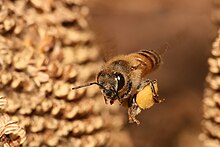
| |
| European honey bee carrying pollen back to the hive | |
| Scientific classification | |
| Kingdom: | |
| Phylum: | |
| Class: | |
| Order: | |
| Family: | |
| Subfamily: | |
| Tribe: | Apini Latreille, 1802
|
| Genus: | Apis |
| Species | |
| |
Honey bees (or honeybees) are bees of the genus Apis, primarily distinguished by the production and storage of honey and the construction of perennial, colonial nests from wax. Honey bees are the only extant members of the tribe Apini, all in the genus Apis. Currently, only seven species of honey bee are recognized, with a total of 44 subspecies,[1] though historically, from six to 11 species have been recognised. Honey bees represent only a small fraction of the roughly 20,000 known species of bees. Some other types of related bees produce and store honey, but only members of the genus Apis[clarification needed]are true honey bees. The study of honey bees is known as apiology.
Origin, systematics and distribution




Honey bees appear to have their center of origin in South and Southeast Asia (including the Philippines), as all but one (i.e. Apis mellifera), of the extant species are native to that region. Notably, living representatives of the earliest lineages to diverge (Apis florea and Apis andreniformis) have their center of origin there.[2]
The first Apis bees appear in the fossil record at the Eocene–Oligocene boundary (23–56 Mya), in European deposits. The origin of these prehistoric honey bees does not necessarily indicate Europe as the place of origin of the genus, only that it occurred there then. A few fossil deposits are known from South Asia, the suspected region of honey bee origin, and fewer still have been thoroughly studied.
No Apis species existed in the New World during human times before the introduction of A. mellifera by Europeans. Only one fossil species is documented from the New World, Apis nearctica, known from a single 14-million-year old specimen from Nevada.[3]
The close relatives of modern honey bees—e.g. bumblebees and stingless bees—are also social to some degree, and social behavior seems a plesiomorphic trait that predates the origin of the genus. Among the extant members of Apis, the more basal species make single, exposed combs, while the more recently evolved species nest in cavities and have multiple combs, which has greatly facilitated their domestication.
Most species have historically been cultured or at least exploited for honey and beeswax by humans indigenous to their native ranges. Only two of these species have been truly domesticated, one (A. mellifera) at least since the time of the building of the Egyptian pyramids, and only that species has been moved extensively beyond its native range.
Today's honey bees constitute three clades.[1][4]
Genetics
The chromosome counts of female bees for the three clades are Micrapis 2N=16, Megapis 2N=16, Apis 2N=32. Drones of all species have 1N chromosome counts. The genome of Apis has been mapped.
Drones (males) are produced from unfertilized eggs, so represent only the DNA of the queen that laid the eggs, i.e. have only a mother. Workers and queens (both female) result from fertilized eggs, so have both a mother and a father. A modified form of parthenogenesis controls sex differentiation. The sex allele is polymorphic, and so long as two different variants are present, a female bee results. If both sex alleles are identical, diploid drones are produced. Honey bees detect and destroy diploid drones after the eggs hatch.
Queens typically mate with multiple drones on more than one mating flight. Once mated, they lay eggs and fertilize them as needed from sperm stored in the spermatheca. Since the number of sex alleles is limited—about 18 are known in Apis—a queen will most likely mate with one or more drones having sex alleles identical with one of the sex alleles in the queen. The queen, then, typically produces a percentage of diploid drone eggs.
Micrapis
Apis florea and Apis andreniformis are small honey bees of southern and southeastern Asia. They make very small, exposed nests in trees and shrubs. Their stings are often incapable of penetrating human skin, so the hive and swarms can be handled with minimal protection. They occur largely sympatrically, though they are very distinct evolutionarily and are probably the result of allopatric speciation, their distribution later converging. Given that A. florea is more widely distributed and A. andreniformis is considerably more aggressive, honey is, if at all, usually harvested from the former only. They are the most ancient extant lineage of honey bees, maybe diverging in the Bartonian (some 40 million years ago or slightly later) from the other lineages, but do not seem to have diverged from each other a long time before the Neogene.[4]
Megapis
One species is recognized in the subgenus Megapis. It usually builds single or a few exposed combs on high tree limbs, on cliffs, and sometimes on buildings. They can be very fierce. Periodically robbed of their honey by human "honey hunters", colonies are easily capable of stinging a human being to death if provoked.
- Apis dorsata, the giant honey bee, is native and widespread across most of South and Southeast Asia.
- Apis dorsata binghami, the Indonesian honey bee, is classified as the Indonesian subspecies of the giant honey bee or a distinct species; in the latter case, A. d. breviligula and/or other lineages would probably also have to be considered species.[5]
- Apis dorsata laboriosa, the Himalayan honey bee, was initially described as a distinct species. Later, it was included in A. dorsata as a subspecies[1] based on the biological species concept, though authors applying a genetic species concept have suggested it should be considered a species.[4] Essentially restricted to the Himalayas, it differs little from the giant honey bee in appearance, but has extensive behavioral adaptations that enable it to nest in the open at high altitudes despite low ambient temperatures. It is the largest living honey bee.
Apis

The eastern species include three or four species. The reddish Koschevnikov's bee (Apis koschevnikovi) from Borneo is well distinct; it probably derives from the first colonization of the island by cave-nesting honey bees. Apis cerana, the eastern honey bee proper, is the traditional honey bee of southern and eastern Asia, kept in hives in a similar fashion to A. mellifera, though on a much smaller and regionalised scale. It has not been possible yet to resolve its relationship to the Bornean A. c. nuluensis and Apis nigrocincta from the Philippines to satisfaction; the most recent hypothesis is that these are indeed distinct species, but that A. cerana is still paraphyletic, consisting of several good species.[4]
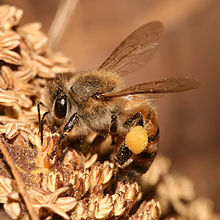
A. mellifera, the most common domesticated species, was the third insect to have its genome mapped. It seems to have originated in eastern tropical Africa and spread from there to Northern Europe and eastwards into Asia to the Tien Shan range. It is variously called the European, western or common honey bee in different parts of the world. Many subspecies have adapted to the local geographic and climatic environments; in addition, hybrid strains, such as the Buckfast bee, have been bred. Behavior, color, and anatomy can be quite different from one subspecies or even strain to another.
Regarding phylogeny, this is the most enigmatic honey bee species. It seems to have diverged from its eastern relatives only during the Late Miocene. This would fit the hypothesis that the ancestral stock of cave-nesting honey bees was separated into the western group of East Africa and the eastern group of tropical Asia by desertification in the Middle East and adjacent regions, which caused declines of food plants and trees that provided nest sites, eventually causing gene flow to cease. The diversity of subspecies is probably the product of a largely Early Pleistocene radiation aided by climate and habitat changes during the last ice age. That the western honey bee has been intensively managed by humans for many millennia – including hybridization and introductions – has apparently increased the speed of its evolution and confounded the DNA sequence data to a point where little of substance can be said about the exact relationships of many A. mellifera subspecies.[4]
Apis mellifera is not native to the Americas, so was not present upon the arrival of the European explorers and colonists. However, other native bee species were kept and traded by indigenous peoples.[6] In 1622, European colonists brought the dark bee (A. m. mellifera) to the Americas, followed later by Italian bees (A. m. ligustica) and others. Many of the crops that depend on honey bees for pollination have also been imported since colonial times. Escaped swarms (known as "wild" bees, but actually feral) spread rapidly as far as the Great Plains, usually preceding the colonists. Honey bees did not naturally cross the Rocky Mountains; they were transported by the Mormon pioneers[7] to Utah in the late 1840s, and by ship to California in the early 1850s.
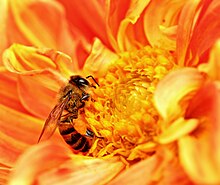
Africanized bee
Africanized bees (known colloquially as "killer bees") are hybrids between European stock and one of the African subspecies A. m. scutellata; they are often more aggressive than and do not create as much of a surplus as European bees, but are more resistant to disease and are better foragers.[citation needed] Originating by accident in Brazil, they have spread to North America and constitute a pest in some regions. However, these strains do not overwinter well, so are not often found in the colder, more northern parts of North America. The original breeding experiment for which the African bees were brought to Brazil in the first place has continued (though not as intended). Novel hybrid strains of domestic and redomesticated Africanized bees combine high resilience to tropical conditions and good yields. They are popular among beekeepers in Brazil.

Beekeeping
Two species of honey bee, A. mellifera and A. cerana indica, are often maintained, fed, and transported by beekeepers. Modern hives also enable beekeepers to transport bees, moving from field to field as the crop needs pollinating and allowing the beekeeper to charge for the pollination services they provide, revising the historical role of the self-employed beekeeper, and favoring large-scale commercial operations.
Colony collapse disorder
Beekeepers in Western countries have been reporting slow declines of stocks for many years, apparently due to impaired protein production, changes in agricultural practice, or unpredictable weather. In early 2007, abnormally high die-offs (30–70% of hives) of European honey bee colonies occurred in North America; such a decline seems unprecedented in recent history. This has been dubbed "colony collapse disorder" (CCD); it is unclear whether this is simply an accelerated phase of the general decline due to stochastically more adverse conditions in 2006, or a novel phenomenon. Research has so far failed to determine what causes it, but the weight of evidence is tentatively leaning towards CCD being a syndrome rather than a disease, as it seems to be caused by a combination of various contributing factors rather than a single pathogen or poison. However, in April of 2013, after a report was released by the European Food Safety Authority identifying the significant risks of the class of pesticides called neonicotinoids, the European Union called for a two-year restriction on neonicotinoid pesticides.[8]
Lifecycle





As in a few other types of eusocial bees, a colony generally contains one queen bee, a fertile female; seasonally up to a few thousand drone bees or fertile males;[9] and a large seasonally variable population of sterile female worker bees. Details vary among the different species of honey bees, but common features include:
1. Eggs are laid singly in a cell in a wax honeycomb, produced and shaped by the worker bees. Using her spermatheca, the queen actually can choose to fertilize the egg she is laying, usually depending on into which cell she is laying. Drones develop from unfertilised eggs and are haploid, while females (queens and worker bees) develop from fertilised eggs and are diploid. Larvae are initially fed with royal jelly produced by worker bees, later switching to honey and pollen. The exception is a larva fed solely on royal jelly, which will develop into a queen bee. The larva undergoes several moultings before spinning a cocoon within the cell, and pupating.
2. Young worker bees clean the hive and feed the larvae. When their royal jelly-producing glands begin to atrophy, they begin building comb cells. They progress to other within-colony tasks as they become older, such as receiving nectar and pollen from foragers, and guarding the hive. Later still, a worker takes her first orientation flights and finally leaves the hive and typically spends the remainder of her life as a forager.
3. Worker bees cooperate to find food and use a pattern of "dancing" (known as the bee dance or waggle dance) to communicate information regarding resources with each other; this dance varies from species to species, but all living species of Apis exhibit some form of the behavior. If the resources are very close to the hive, they may also exhibit a less specific dance commonly known as the "round dance".
4. Honey bees also perform tremble dances, which recruit receiver bees to collect nectar from returning foragers.
5. Virgin queens go on mating flights away from their home colony to a drone congregation area, and mate with multiple drones before returning. The drones die in the act of mating. Queen honey bees do not mate with drones from their home colony.
6. Colonies are established not by solitary queens, as in most bees, but by groups known as "swarms", which consist of a mated queen and a large contingent of worker bees. This group moves en masse to a nest site scouted by worker bees beforehand. Once they arrive, they immediately construct a new wax comb and begin to raise new worker brood. This type of nest founding is not seen in any other living bee genus, though several groups of vespid wasps also found new nests by swarming (sometimes including multiple queens). Also, stingless bees will start new nests with large numbers of worker bees, but the nest is constructed before a queen is escorted to the site, and this worker force is not a true "swarm".
Winter survival
In cold climates, honey bees stop flying when the temperature drops below about 10 °C (50 °F) and crowd into the central area of the hive to form a "winter cluster". The worker bees huddle around the queen bee at the center of the cluster, shivering to keep the center between 27 °C (81 °F) at the start of winter (during the broodless period) and 34 °C (93 °F) once the queen resumes laying. The worker bees rotate through the cluster from the outside to the inside so that no bee gets too cold. The outside edges of the cluster stay at about 8–9 °C (46–48 °F). The colder the weather is outside, the more compact the cluster becomes. During winter, they consume their stored honey to produce body heat. The amount of honey consumed during the winter is a function of winter length and severity, but ranges in temperate climates from 15 to 50 kg (30 to 100 pounds).[10]
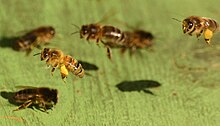
Pollination
Species of Apis are generalist floral visitors, and will pollinate a large variety of plants, but by no means all plants. Of all the honey bee species, only Apis mellifera has been used extensively for commercial pollination of crops and other plants. The value of these pollination services is commonly measured in the billions of dollars. Bees collect 66 pounds of pollen per year, per hive.[11]



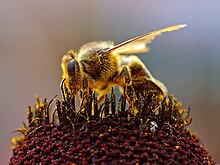
Bee products
Honey
Honey is the complex substance made when the nectar and sweet deposits from plants and trees are gathered, modified, and stored in the honeycomb by honey bees as a food source for the colony. All living species of Apis have had their honey gathered by indigenous peoples for consumption, though for commercial purposes, only A. mellifera and A. cerana have been utilized to any degree. Honey is sometimes also gathered by humans from the nests of various stingless bees.
In 1911, a bee culturist estimated a quart (about a litre) of honey represented bees flying over an estimated 48,000 miles to gather the nectar needed to produce the honey.[12]
Nectar
Nectar, a liquid high in sucrose, is produced in plant glands known as nectaries. It is an important energy resource for honey bees and plays a significant role in foraging economics and evolutionary differentiation between different subspecies. It was proposed through an experiment conducted with the African honey bee, A. m. scutellata, that nectar temperature impacts the foraging decisions of honey bees.[13]
Beeswax
Worker bees of a certain age will secrete beeswax from a series of glands on their abdomens. They use the wax to form the walls and caps of the comb. As with honey, beeswax is gathered by humans for various purposes.
Pollen
Bees collect pollen in the pollen basket and carry it back to the hive. In the hive, pollen is used as a protein source necessary during brood-rearing. In certain environments, excess pollen can be collected from the hives of A. mellifera and A. cerana. It is often eaten as a health supplement. It also has been used with moderate success as a source of pollen for hand pollination However, pollen collected by bees and harvested for pollination must be used within a few hours because it loses its potency rapidly, possibly because of the effects of enzymes or other chemicals from the bees; hand-collected pollen may remain usable for weeks, if stored promptly under suitable conditions.
Propolis
Propolis or bee glue is created from resins, balsams, and tree saps. Those species of honey bees that nest in tree cavities use propolis to seal cracks in the hive. Dwarf honey bees use propolis to defend against ants by coating the branch from which their nest is suspended to create a sticky moat. Propolis is consumed by humans as a health supplement in various ways and also used in some cosmetics.
Sexes and castes
The two sexes of honey bee are: females (workers and queens) and males (or drones). A caste is a different form, morphologically or reproductively, within the same sex of a species. In sum, the three types of honey bees are drones, workers, and queens, and two female castes: queens and workers.
Drones
Males or drones are typically haploid, having only one set of chromosomes. They are produced by the queen if she chooses not to fertilize an egg; or by an unfertilized laying worker. Diploid drones may be produced if an egg is fertilized but is homozygous for the sex-determination allele. Drones take 24 days to develop and may be produced from summer through autumn. Drones have large eyes used to locate queens during mating flights. Drones do not have a sting.
Workers
Workers are female bees and have two sets of chromosomes. They are produced from an egg that the queen has selectively fertilized from stored sperm. Workers typically develop in 21 days. A typical colony may contain as many as 60,000 worker bees. Workers exhibit a wider range of behaviors than either queens or drones. Their duties change upon the age of the bee in the following order (beginning with cleaning out their own cell after eating through their capped brood cell): feed brood, receive nectar, clean hive, guard duty, and foraging. Some workers engage in other specialized behaviors, such as "undertaking" (removing corpses of their nestmates from inside the hive).
Workers have morphological specializations, including the corbiculum or pollen basket, abdominal glands that produce beeswax, brood-feeding glands, and barbs on the sting. Under certain conditions (for example, if the colony becomes queenless), a worker may develop ovaries.
Queens
Queen honey bees, like workers, are female. They are created at the decision of the worker bees by feeding a larva only royal jelly throughout its development, rather than switching from royal jelly to pollen once the larva grows past a certain size. Queens are produced in oversized cells and develop in only 16 days. Queens have a different morphology and behavior from worker bees. In addition to the greater size of the queen, she has a functional set of ovaries, and a spermatheca, which stores and maintains sperm after she has mated. The sting of queens is not barbed like a worker's sting, and queens lack the glands that produce beeswax. Once mated, queens may lay up to 2,000 eggs per day. They produce a variety of pheromones that regulate behavior of workers, and helps swarms track the queen's location during the migratory phase.
Defense
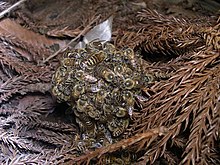
All honey bees live in colonies where the workers sting intruders as a form of defense, and alarmed bees release a pheromone that stimulates the attack response in other bees. The different species of honey bees are distinguished from all other bee species (and virtually all other Hymenoptera) by the possession of small barbs on the sting, but these barbs are found only in the worker bees. The sting and associated venom sac of honey bees are also modified so as to pull free of the body once lodged (autotomy), and the sting apparatus has its own musculature and ganglion, which allow it to keep delivering venom once detached. The worker dies after the sting becomes lodged and is subsequently torn loose from the bee's abdomen. The honey bee's venom, known as apitoxin, carries several active components, the most abundant of which is melittin, and the most destructive Phospholipase A2.
This complex apparatus, including the barbs on the sting, is thought to have evolved specifically in response to predation by vertebrates, as the barbs do not usually function (and the sting apparatus does not detach) unless the sting is embedded in fleshy tissue. While the sting can also penetrate the membranes between joints in the exoskeleton of other insects (and is used in fights between queens), in the case of Apis cerana japonica, defense against larger insects such as predatory wasps (e.g. Asian giant hornet) is usually performed by surrounding the intruder with a mass of defending worker bees, which vibrate their muscles vigorously to raise the temperature of the intruder to a lethal level.[14] Previously, heat alone was thought to be responsible for killing intruding wasps, but recent experiments have demonstrated the increased temperature in combination with increased carbon dioxide levels within the ball produce the lethal effect.[15][16] This phenomenon is also used to kill a queen perceived as intruding or defective, an action known to beekeepers as 'balling the queen', named for the ball of bees formed.
In the case of those honey bee species with open combs (e.g., A. dorsata), would-be predators are given a warning signal that takes the form of a "Mexican wave" that spreads as a ripple across a layer of bees densely packed on the surface of the comb when a threat is perceived, and consists of bees momentarily arching their bodies and flicking their wings.[17]
Communication
Honey bees are known to communicate through many different chemicals and odors, as is common in insects, but also using specific behaviours that convey information about the quality and type of resources in the environment, and where these resources are located. The details of the signalling being used vary from species to species; for example, the two smallest species, Apis andreniformis and A. florea, dance on the upper surface of the comb, which is horizontal (not vertical, as in other species), and worker bees orient the dance in the actual compass direction of the resource to which they are recruiting.
Apis mellifera carnica honey bees use their antennae asymmetrically for social interactions with a strong lateral preference to use their right antenna.[18][19]
Symbolism
Both the Atharva Veda[20] and the ancient Greeks associated lips anointed with honey with the gift of eloquence and even of prescience. The priestess at Delphi was the "Delphic Bee". The Quran has a chapter titled "The Bee".
A community of honey bees has often been employed throughout history by political theorists as a model of human society:
This image occurs in Aristotle and Plato; in Virgil[21] and Seneca; in Erasmus and Shakespeare; in Marx and Tolstoy.[22]
Honey bees, signifying immortality and resurrection, were royal emblems of the Merovingians, revived by Napoleon.[23] The bee also is the heraldic emblem of the Barberini.
See also
- Apiology
- Bee sting
- Bees and toxic chemicals
- Honey bee life cycle
- More Than Honey—a 2012 Swiss documentary film on the current state of honey bees and beekeeping
References
- ^ a b c Michael S. Engel (1999). "The taxonomy of recent and fossil honey bees (Hymenoptera: Apidae: Apis)". Journal of Hymenoptera Research. 8: 165–196.
- ^ Deborah R. Smith, Lynn Villafuerte, Gard Otisc & Michael R. Palmer (2000). "Biogeography of Apis cerana F. and A. nigrocincta Smith: insights from mtDNA studies" (PDF). Apidologie. 31 (2): 265–279. doi:10.1051/apido:2000121.
{{cite journal}}: CS1 maint: multiple names: authors list (link)[dead link] - ^ Michael S. Engel, I. A. Hinojosa-Diaz & A. P. Rasnitsyn (2009). "A honey bee from the Miocene of Nevada and the biogeography of Apis (Hymenoptera: Apidae: Apini)". Proceedings of the California Academy of Sciences. 60 (3): 23–38.
- ^ a b c d e Maria C. Arias & Walter S. Sheppard (2005). "Phylogenetic relationships of honey bees (Hymenoptera:Apinae:Apini) inferred from nuclear and mitochondrial DNA sequence data". Molecular Phylogenetics and Evolution. 37 (1): 25–35. doi:10.1016/j.ympev.2005.02.017. PMID 16182149.
Maria C. Arias & Walter S. Sheppard (2005). "Corrigendum to "Phylogenetic relationships of honey bees (Hymenoptera:Apinae:Apini) inferred from nuclear and mitochondrial DNA sequence data"". Molecular Phylogenetics and Evolution. 40 (1): 315. doi:10.1016/j.ympev.2006.02.002. - ^ Nathan Lo, Rosalyn S. Gloag, Denis L. Anderson & Benjamin P. Oldroyd (2009). "A molecular phylogeny of the genus Apis suggests that the Giant Honey Bee of the Philippines, A. breviligula Maa, and the Plains Honey Bee of southern India, A. indica Fabricius, are valid species". Systematic Entomology. 35 (2): 226–233. doi:10.1111/j.1365-3113.2009.00504.x.
{{cite journal}}: CS1 maint: multiple names: authors list (link) - ^ Charles F. Calkins, "Beekeeping in Yucatán: A Study in Historical-Cultural Zoogeography (PhD diss., University of Nebraska, 1974), as quoted in Crane, World History of Beekeeping, p. 292. Calkins cites the original translated source as Hernán Cortés, Letters of Cortés: The Five Letters of Relation from Fernando Cortes to the Emperor Charles V, trans. and ed. Francis A. MacNutt (New York: Putnam, 1908), 1:145.
- ^ Horn, Bees in America, p. 80–81. http://maxwellinstitute.byu.edu/publications/review/?vol=20&num=1&id=694#_ednref30
- ^ McDonald-Gibson, Charlotte. "'Victory for bees' as European Union bans neonicotinoid pesticides blamed for destroying bee population". http://www.independent.co.uk. The Independent. Retrieved 2 July 2014.
{{cite web}}: External link in|website= - ^ James L. Gould & Carol Grant Gould (1995). The Honey Bee. Scientific American Library. p. 19. ISBN 978-0-7167-6010-8.
{{cite book}}:|access-date=requires|url=(help) - ^ What do bees do in the winter?
- ^ Back Yard Beekeepers Association. "Facts about Honeybees." http://www.backyardbeekeepers.com/facts.html
- ^ "A Quart of Honey Means 48,000 miles of flight" Popular Mechanics, December 1911, p. 889.
- ^ Fewell, Jennifer H.; Susan M. Bertram (2002). "Evidence for genetic variation in worker task performance by African and European honeybees". Behavioral Ecology and Sociobiology. 52: 318–25. doi:10.1007/s00265-002-0501-3.
- ^ C. H. Thawley. "Heat tolerance as a weapon". Davidson College. Retrieved June 1, 2010.
- ^ Michio Sugahara & Fumio Sakamoto (2009). "Heat and carbon dioxide generated by honeybees jointly act to kill hornets". Naturwissenschaften. 96 (9): 1133–6. doi:10.1007/s00114-009-0575-0. PMID 19551367.
- ^ Victora Gill (July 3, 2009). "Honeybee mobs overpower hornets". BBC News. Retrieved July 5, 2009.
- ^ Giant Honeybees Use Shimmering 'Mexican Waves' To Repel Predatory Wasps - ScienceDaily
- ^ Rogers, Lesley J.; Elisa Rigosi; Elisa Frasnelli; Giorgio Vallortigara (27 June 2013). "A right antenna for social behaviour in honeybees". Scientific Reports (3). Macmillan Publishers. doi:10.1038/srep02045.
- ^ Honeybees use right antennae to tell friend from foe July 1, 2013 Science News
- ^ "O Asvins, lords of brightness, anoint me with the honey of the bee, that I may speak forceful speech among men! Atharva Veda 91-258, quoted in Maguelonne Toussaint-Samat (Anthea Bell, tr.) The History of Food, 2nd ed. 2009:14.
- ^ Virgil, Georgics, book IV.
- ^ Bee Wilson (2004). The Hive: The Story of the Honeybee. London: John Murray. p. 14. ISBN 0-7195-6598-7.
- ^ "The symbols of empire". Napoleon.org. Retrieved June 1, 2010.
Further reading
- Adam, Brother. In Search of the Best Strains of Bees. Hebden Bridge, W. Yorks: Northern Bee Books, 1983.
- Adam, Brother. Bee-keeping at Buckfast Abbey. Geddington, Northants: British Bee Publications, 1975.
- Aldersey-Williams, H. Zoomorphic: New Animal Architecture. London: Laurence King Publishing, 2003.
- Alexander, P. Rough Magic: A Biography of Sylvia Plath. New York: Da Capo Press, 2003.
- Allan, M. Darwin and his flowers. London: Faber & Faber, 1977.
- Alston, F. Skeps, their History, Making and Use. Hebden Bridge, W. Yorks: Northern Bee Books, 1987.
- Barrett, P. The Immigrant Bees 1788 to 1898, 1995.
- Barrett, P. William Cotton.
- Beuys, J. Honey is Flowing in All Directions. Heidelberg: Edition Staeck, 1997.
- Bevan, E. The Honey-bee: Its Natural History, Physiology and Management. London: Baldwin, Cradock & Joy, 1827.
- Bill, L. For the Love of Bees. Newton Abbot, Devon: David & Charles, 1989.
- Bodenheimer, F.S. Insects as Human Food The Hague: Dr. W. Junk, 1951.
- Brothwell, D., Brothwell, P. Food in Antiquity. London: Thames & Hudson, 1969.
- Engel, Michael S. & Grimaldi, David (2005): Evolution of the Insects. Cambridge University Press.
- Kak, Subhash C. (1991): The Honey Bee Dance Language Controversy. The Mankind Quarterly Summer 1991: 357–365. HTML fulltext
- Lanman, Connor H. The Plight of the Bee: The Ballad of Man and Bee. San Francisco, 2008.
- Lindauer, Martin (1971): Communication among social bees. Harvard University Press.
External links
- How Honey Bees are celebrated in Canada through, "Day of the Honey Bee"
- Beediseases Honey bee diseases website by Dr. Guido Cordoni.
- Music video and dance used in schools to raise awareness of honey bee colony collapse disorder.
